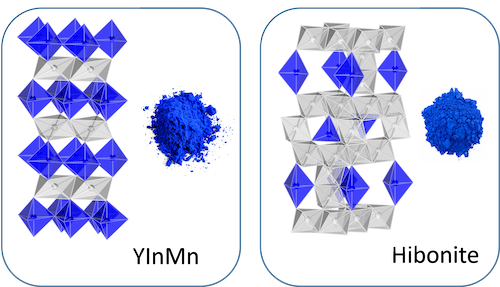Research Looks at Pigment Design
THURSDAY, JANUARY 16, 2020
A researcher out of Oregon State University’s College of Science is looking at new ways to design more pigments that are stable, durable and non-toxic with vivid hues, according to the university.
Mas Subramanian and his team, which discovered YinMn Blue in 2009, are analyzing the structure of pigments based on hibonite, a mineral found in meteorites.
Pigmented History
In 2009 scientists at OSU, led by Subramanian, were exploring the electronic properties of manganese when mixed with different chemicals.
When graduate student Andrew Smith heated black manganese oxide, yttrium and indium to 2,000 F, a compound with a striking blue hue was pulled from the furnace.

 |
| Images: OSU |
|
A researcher our of Oregon State University’s College of Science is looking at new ways to design more pigments that are stable, durable and non-toxic with vivid hues, according to the university. |
“If I hadn’t come from an industry research background—DuPont has a division that developed pigments, and obviously they are used in paint and many other things—I would not have known this was highly unusual, a discovery with strong commercial potential,” Subramanian said.
Most blue pigments are unstable; they easily fade, and are made of toxic materials. But Subramanian realized a pigment synthesized at such a high temperature would be stable.
“(YInMn Blue) is more durable, safe and fairly easy to produce … it also appears to be a new candidate for energy efficiency,” Subramanian said.
Energy companies have echoed Subramanian’s sentiments, and have expressed interest in using YInMn Blue because of its pigment structure. Oregon State says its infrared reflectivity is about 40%, and when used in roofing materials could help keep a property cool and improve energy efficiency by reducing the need for air conditioning.
Shepherd Color Company (West Chester Township, Ohio) reached a license agreement in 2017 to market the first amount of YinMn Blue pigment.
As part of its “Cool Roofs” initiative, Shepherd Color Company tested YinMn Blue’s infrared reflective properties at its Laboratory for Advanced Innovative Research, near Denver.
Using two house models, researchers used a standard dark blue—made with high durability pigments—for one small, metal-paneled roof, and a coating of YInMn Blue on another. Both models were placed outside on a sunny, warm day.
 |
|
Shepherd Color Company (West Chester Township, Ohio) reached a license agreement in 2017 to market the first amount of YinMn Blue pigment. |
Using an infrared imager to test each roof, it was revealed that the standard roof was much hotter than the YInMn Blue model. The imager’s temperature sensing function showed the standard blue roof was 191 F; the YInMn Blue roof was 168 F.
According to Shepherd, YInMn’s high temperature calcination production process makes the color technology highly inert, meaning that it can be used in a variety of coatings and plastics while retaining weathering properties. YinMn Blue is infrared-reflective, but is also extremely opaque in the UV and visible parts of the solar spectrum, according to the company.
Shepherd announced that the shade was ready for commercial sale in the fall of 2017. At the time, the Environmental Protection Agency has issued Shepherd Color a Low Volume Exemption, which allowed for it to be used in industrial coatings and plastics.
New Research
“Most pigments are discovered by chance,” Subramanian said. “The reason is because the origin of the color of a material depends not only on the chemical composition, but also on the intricate arrangement of atoms in the crystal structure. So, someone has to make the material first, then study its crystal structure thoroughly to explain the color.”
For instance, before YinMn Blue, the last blue discovery was cobalt aluminum oxide-based blue or “Cobalt Blue,” which is still widely used today. The production of Cobalt Blue, however, required a lot of cobalt ion, which can be hazardous to both humans and the environment.
 |
|
In 2009 scientists at OSU, led by Subramanian (above), were exploring the electronic properties of manganese when mixed with different chemicals. |
Enter in the research on hibonite-based blue pigments.
Hibonite-based pigments are more thermally stable than Cobalt Blue due to its higher preparation temperature and ability to remain unaltered structurally and optically upon exposure to strong acid and alkali, according to the university.
The researchers report that an oxide containing calcium, aluminum and titanium, along with cobalt or nickel, can crystallize into a structure similar to hibonite that allows for a series of blue colors.
The study showed the presence of chromophores in a “trigonal bipyramidal-shaped crystal environment” is critical for color enhancement.
“This part of the crystal structure of hibonite, like YInMn blue, allows for vivid blue colors with a reddish hue,” Subramanian said. “The hibonite blue exhibits better energy-saving, heat-reflecting properties than traditional cobalt blue due to the presence of titanium and less cobalt content.
“In nature, hibonite is only found in meteorites that have been subjected to thousands of degrees of temperature when they go through the Earth’s atmosphere, so it makes sense that the structure is remarkably stable,” he added. “These kinds of mineral structures are probably the future for designing durable and safe inorganic pigments.”
Determining the key ingredients for vivid colors should allow for shorter time periods between pigment discoveries—at least, that’s the goal.
Tagged categories: Coating chemistry; Color + Design; Pigments; Research and development









